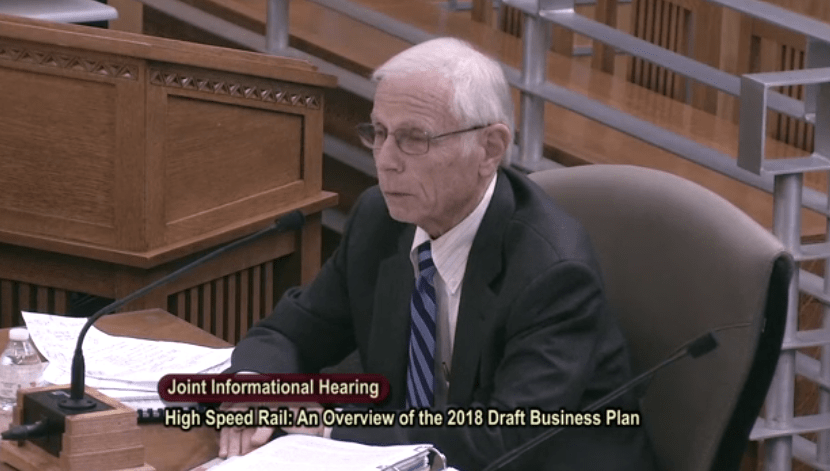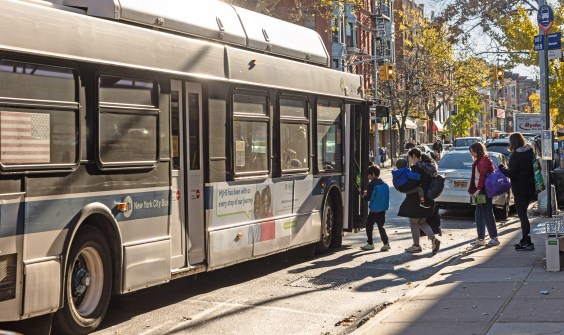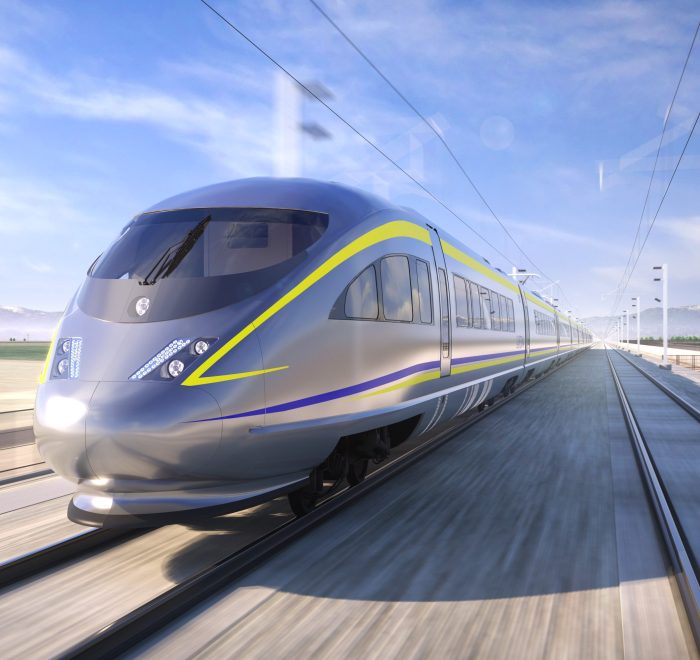CA Legislature Ponders the Future of High-Speed Rail Program
4:06 PM PDT on April 5, 2018

Louis Thompson of the High-Speed Rail Peer Review Group testified at a previous legislative hearing, saying what he has said so many times before.
The California legislature held two hearings this week to discuss the future of the high-speed rail program. The hearings were prompted by the recent release of the California High-Speed Rail Authority's (CAHSRA) updated business plan, which issued new—higher—estimates of the project's costs and a longer timeline for building its parts.
At a Crossroads
CAHSRA's new director, Brian Kelly—who until recently was head of the California State Transportation Agency—told both committees that the plan identifies enough money to complete most of its component parts. “In essence,” he said, the remaining funding gap is the same as the cost to build a tunnel through the Pacheco Pass to connect the Central Valley with rail improvements in the Bay Area.
But the identified funds rely on continued large allocations from the state's cap-and-trade program, which has been a volatile source of funding until now and is currently only authorized until 2030. And the business plan calls for borrowing against uncertain future cap-and-trade revenue to build the system sooner than later.
The two hearings, one in the Assembly Transportation Committee and the other a joint Senate hearing between the Transportation and Housing Committee and the Budget Subcommittee on Resources, Environmental Protection, Energy, and Transportation, listened to largely the same testimony from mostly the same people. But the tone of each hearing differed. The Assembly committee, chaired by Jim Frazier (D-Oakley), was combative and hostile, with Assemblymembers tending towards grandstanding, focusing on “promises made to the public” and rising costs, but never quite getting to a substantive discussion of how to move forward.
Assembly Chair Frazier said that the program was “at a crossroads,” and the legislature, as a funding partner, needed to figure out what the next steps should be.
But in the Senate hearing, when Senator Jim Nielsen (R-Tehama) blustered that the program is “like a voracious beast” and should be sent back to the voters, Senator Scott Wiener (D-San Francisco) quickly shot that idea down.
“I don't think this should go back to the voters,” he said. “We should just build the damn system—excuse my language—and do our job.”
Kelly, for his part, repeated at both hearings that the project never did have all its funding up front, nor was it supposed to. When the original authorizing legislation, Prop 1A, passed, it included funding to the tune of $9 billion, which, said Kelly, was about one-fifth of the total amount the project was estimated to need at the time.
Costs have risen, and now, he says, the funding in hand covers about one-third of final project cost estimates. There is no real surprise here—voters were certainly never promised that they would be able to travel between San Francisco and Los Angeles for $9 billion, as some seem to imply. Environmental clearances, obtaining right of way, and figuring out alignments in the face of local objections is expensive and time-consuming. The volatility of funding sources, both state and federal, given politics as well as a host of other unknowable factors, adds to the uncertainty of cost estimates.
Meanwhile, the project is being built, and it is bringing major economic benefits to the state already. Kelly claimed the program was having a $6 billion impact on the state's economy, saying that one-third of the jobs in the Fresno area could be attributed directly or indirectly to the high-speed rail program.
“We still have challenges,” he said, “but with the revenues that we have in hand, we can deliver 224 miles of high-speed rail.”
Options for Moving Forward
Louis Thompson, testifying for the High-Speed Rail Peer Review Group, outlined four possible options for action at this point (“There may be others,” he said):
First, the state could abandon the project. This would mean stranding all the current assets, including the half-built viaduct near Fresno, losing a considerable number of jobs and impacting many small businesses, and having to pay back stimulus funds the federal government has contributed to the project. This is not really a credible option, said Thompson.
Second, the Central Valley portion of the project could be completed, and the state “could keep whatever value we could create there,” serving San Joaquin Valley cities with a much better rail system than is possible with the current Amtrak-sharing-tracks-with-freight situation. With this option, “you would at least complete something usable in the Central Valley,” he said, which should mean not having to pay back the federal funds.
Third, the Central Valley portion could be completed between Bakersfield and Merced; current Caltrain electrification plans could be extended to Gilroy, and plans to reconfigure downtown L.A.'s Union Station could proceed. All three areas would benefit from faster, cleaner, more frequent train connections with these project pieces complete, even without being connected in one continuous line. The Union Station project, for example, would increase regional rail capacity by as much as sixty percent, according to a representative from L.A. Metro, making faster trips possible from San Luis Obispo to San Diego.
Then, the last remaining piece--the Pacheco Pass Tunnel--could be considered a separate finishing project, and it would wait until funding could be found specifically for it.
This option, said Thompson, makes the best use of the current situation. It would provide real, near-term benefits, although financing for the remainder of the system would still be up in the air.
Fourth, the state could recommit to long-haul high-speed rail from San Francisco to Los Angeles as originally envisioned, understanding that the costs will probably end up being much larger than originally estimated. This option, said Thompson, “cannot be done with current funding provisions or sources.”
What is clear to the High-Speed Rail Peer Review Group, he said, is that it is “no longer fair or credible to demand this project be built with funding sources that are inadequate and unreliable.”
“This is not a new issue,” he added. “There has always been a gap in funding. What is new is the increasing size of the gap.”
Questions
Assemblymembers wanted to know what would happen if the project were abandoned, whether the federal government could forgive the debt, whether there were better uses for the money, whether, if abandoned, it could be used for freight instead—that last question from committee chair Jim Frazier. The answer, in short, was no.
In the Senate Hearing, Senator Cathleen Galgiani (D-Stockton) expressed frustration that her input into the project did not seem to be taken seriously, and she reminded those present that other high-speed rail systems were rarely built in one go.
“In Europe and other places, they built it in stretches,” she said, connecting new rail with existing systems and putting the different sections to use as soon as they were complete. “You never set out to build an entire system at once,” she said. Senator Galgiani knows that her Central Valley district desperately needs good rail options to give people alternatives to driving, and that even a system built just in the Central Valley would not be a railroad line “to nowhere,” as some critics have implied.
The takeaway being: Don't dismiss the Central Valley. Fresno, at its center, is the fifth most populous city in California.
“Please take this seriously,” Galgiani told Kelly. “One of the reasons we were able to get cap-and-trade money [for high-speed rail] is because of agreements we made to build connected systems” that serve local areas as well as cross the entire state.
Kelly responded that the new business plan aims to do exactly that. “With constrained funding,” he said, “we have to make investments that build [the system] incrementally.”
CAHSRA's approach, he said, is to provide mobility and maximize connectivity for Californians, “whether that means improving Amtrak or building a connected electric service to Amtrak,” or whatever it takes so that “the public can start receiving benefits from the system earlier [rather] than later.”
If high-speed rail can connect Bakersfield to Merced, and then help make connections on Amtrak to Sacramento or the ACE train to Silicon Valley, it would be an improvement over what is available today.
Is it Worth the Investment?
Turn that question around: are the expensive highways California is so enamored of worth it?
There are legitimate concerns about this megaproject. But legislators instead focused on whether the final project will take two or three hours to travel between L.A. and San Francisco, and on whether using cap-and-trade funds to pay for debt on bonds to build the project—rather than directly for the project itself—is a legitimate use of that funding source.
The big question that went unasked at these hearings is whether California should be investing so much time and energy into a rail project that will likely induce sprawl—encouraging commuters to travel much longer distances than make sense now—and which may very well induce more driving, not less, especially where its destinations are ill-served by connecting transit. Proponents tout the project's future ability to substitute trains for air travel, without thinking through the emissions repercussions of freeing up airports to serve longer trips, as SFO is planning to do.
But there is no doubt that improving and increasing existing transit and local connections—providing fast, frequent train service for people who believe driving is their only viable commute option—will benefit everyone. If that means Caltrain goes electric and increases service along the San Francisco peninsula, that is not a waste of time and money. If it means creating a faster alternative for rail commuters now sharing tracks with freight trains in the Central Valley, that is no waste of effort.
Besides, until California transportation planners begin to give serious consideration to the sprawl-inducing impacts of building highways, still a popular use of state money, there's no reason to point the finger at rail.
The CAHSR 2018 Draft Business Plan is open for public comment until May 9.
Streetsblog California editor Melanie Curry has been thinking about transportation, and how to improve conditions for bicyclists, ever since commuting to school by bike long before bike lanes were a thing. She was Managing Editor at the East Bay Express, editor of Access Magazine for the University of California Transportation Center, and earned her Masters in City Planning from UC Berkeley.
Read More:
Stay in touch
Sign up for our free newsletter
More from Streetsblog California
Sudden State Funding Freeze Leaves Transit Agencies Hanging
Transit agencies were caught off guard by a 60-day funding freeze announced on the day they were expecting the allocations
Friday Video: How to Make Places Safe For Non-Drivers After Dark
A top Paris pedestrian planner, a leading GIS professional, and Streetsblog's own Kea Wilson weigh in on the roots of America's nighttime road safety crisis, and the strategies that can help end it.
Friday’s Headlines
Is your city safe for bicycling? Progress on CA high-speed rail; E-bikes are game changers; More
LAPD Was Crossing Against Red Light in Crash that Killed Pedestrian and Injured Six in Hollywood
The department says the officers had turned on their lights and sirens just before crossing. Their reasons for doing so remain unknown.
Wider Highways Don’t Solve Congestion. So Why Are We Still Knocking Down Homes for Them?
Highway expansion projects certainly qualify as projects for public use. But do they deliver a public benefit that justifies taking private property?




